By Bruce R. Maslin and Stephen van Leeuwen
Note: The project described below is now completed. An electronic key (on CD) to the Wattles of the Pilbara is now available for purchase from the Department of Environment and Conservation.
Aim
The aim of this project is to produce a book and accompanying CD that will provide easy identification and access to relevant information for Pilbara Acacias in order to facilitate their management and use in nature conservation, rehabilitation and sustainable utilisation. The taxonomy of Pilbara Wattles will be clarified in conjunction with this project and the results of this work will be published in the journal Nuytsia.
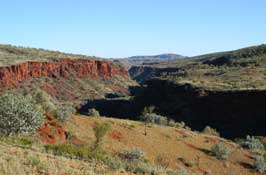
Munjina East Gorge, Hamersley Range
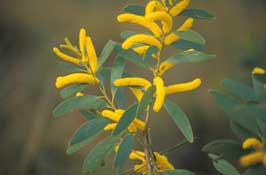
Acacia hamersleyensis
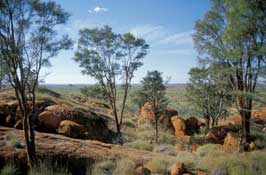
Spear Hill
Background
Acacia (Wattle) is the largest genus of woody plants in Australia (containing almost 1000 species) and is a conspicuous element of many landscapes, particularly in arid and semi-arid regions, which occupy about 75% of the country. The Pilbara represents a major centre of species richness for Acacia in Western Australia with around 100 taxa recorded for the region. These species dominate many Pilbara ecosystems; they are important in nature conservation programs and are obviously an important constituent in mine site and other land rehabilitation programs. Some species also provide an important source of fodder for the pastoral industry during drought times and many have ethnobotanical and cultural significance to Aboriginal people.
Pilbara Wattles are a very variable group of plants. These species are often difficult to identify and a number are in need of critical taxonomic revision. Since detailed work on the Pilbara Acacia flora commenced around 20 years ago considerable taxonomic, ecological and biological information has been acquired but much of this data remains unpublished and/or is scattered through the literature, in herbarium records or simply in peoples heads. There is a need for this information to be assembled, synthesised and made available for general use.
Results from the Pilbara project will feed into the electronic information system for Australian Acacias, called WATTLE. This user-friendly identification tool enables species to be quickly and accurately identified and provides access to relevant information about them. Furthermore, WATTLE enables users to quickly and easily decide what species to grow where, and for what purpose, by providing interactive querying based on ecological, biological, geographic and utilisation criteria, thus facilitating effective management, conservation and utilisation of this large and important group of plants. The ability to quickly and reliably identify the species and to access information concerning them has particular relevance at the moment in view of the Pilbara Biological Survey project which is currently under way.
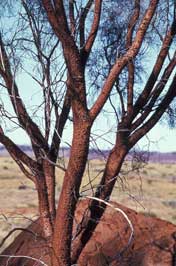
Acacia cyperophylla
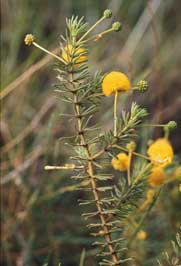
A. spondylophylla
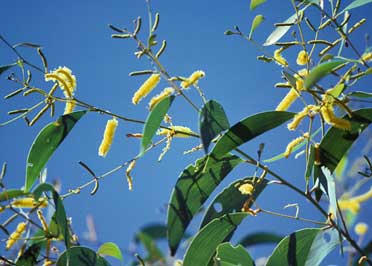
A. tumida var. pilbarensis
Definition of the region
For the purpose of this project the Pilbara region the Fortescue Botanical District as defined by Beard (1980), which is essentially the same as the Pilbara region as used by the Interim Biogeographic Regionalisation for Australia (IBRA).
Key components of the project
Define and describe each Acacia within the Pilbara, and where necessary discuss its variation and publish any that are new. This activity will provide the necessary stable names base for the project and will involve all taxa (namely, species, subspecies, varieties, hybrids and informal variants).
- Assemble relevant information on morphology, biology, ecology, distribution, utilisation, etc. for each taxon. These data will be presented in plain language and, where appropriate, encoded for electronic keying purposes.
- Illustrate each taxon by detailed line drawings, colour photographs and distribution maps.
- Assess conservation status and rehabilitation relevance of each taxon.
- Provide tools enabling effective and efficient taxon identification (in both conventional and electronic formats).
- Publish results as a ‘Field guide’ book, with accompanying CD.
The Pilbara Wattles
The list of Pilbara Wattles comprises about 120 different taxonomic entities. This list includes not only the formally described species, subspecies and varieties but also a number of hybrids and informal taxa (some of uncertain taxonomic status and which are currently under investigation). Photographs of many of these species are available for viewing on WorldWideWattle.
Request
If you have photographs that you would like to make available to the Wattles of the Pilbara project then please contact Bruce Maslin at: Bruce.Maslin@outlook.com (tel: (08) 9334 0510 or 0429 334 051). All photographs used will be fully acknowledged. Similarly, if you have information concerning Pilbara Wattles that you wish to communicate then we would like to hear from you.
Acknowledgements
This project is being conducted under the auspices of the Western Australian Department of Environment and Conservation. It is being generously supported financially by Robe River Mining under the auspices of the West Angelas Coondewanna West Environmental Offsets Agreement.
 |
 |
